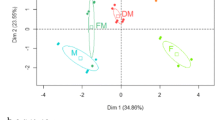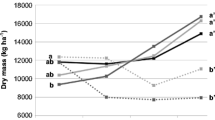Abstract
Aims
In this study, we aimed to understand effects and mechanisms of legume species and their relative abundance on soil N, species recruitment, and productivity in mixed grassland. We also assessed the utilization prospect of several legumes in natural grassland.
Methods
In 2006, grass-legume combinations (GLCs) with different ratios (GLR) were established using Leymus chinensis and four legume species (Medicago ruthenica, Lespedeza daurica, Medicago falcata, and Medicago sativa). In 2009, plant and soil samples were taken to examine the differences in soil nitrogen (N) properties, biological N fixation (BNF), recruitment characteristics, and aboveground biomass of the community under different mixture patterns.
Results
Soil total N and available N concentration increased when legume component increased from GLR 1:0 (grass monoculture) to GLR 1:1 (grass:legume 1:1) but decreased as legume component increased further from GLR 1:3 (grass:legume 1:3) to GLR 0:1 (legume monoculture). GLR 1:1 had the highest BNF in most GLCs except for L. chinensis-M. falcata. For any GLR with legume, L. chinensis-M. sativa combination (L-MS) had higher soil total N, available N, water content, and BNF. The legume combinations with a GLR lower than 1:1 resulted in more species recruitments compared with the grass monoculture, and L-MS induced relatively more species recruitments than other GLCs, which were correlated with improved soil water and NO3 −-N status. The grassland productivity increased as the GLR decreased; in any GLRs with legume, higher productivity was found under L-MS combination, and current results showed that grassland productivity was positively linked to soil NO3 −-N availability influenced by grass-legume mixture.
Conclusions
We concluded that the species and relative abundance of legumes had great impact on soil N status, species recruitment, and productivity in this temperate grassland ecosystem. In this study site, legume introduction can be considered as an alternative to N fertilization for increasing grassland productivity. M. sativa has the greatest economic and ecological potential species to be mixed into natural temperate steppe grassland, and grass-legume ratio 1:1 is the best combination in mixed communities.


Similar content being viewed by others
References
Armstrong RD, Kuskopf BJ, Millar G, Whitbread AM, Standley J (1999) Changes in soil chemical and physical properties following legumes and opportunity cropping on a cracking clay soil. Anim Prod Sci 39(4):445–456
Austin AT, Yahdjian L, Stark JM, Belnap J, Porporato A, Norton U, Ravetta DA, Schaeffer SM (2004) Water pulses and biogeochemical cycles in arid and semiarid ecosystems. Oecologia 141(2):221–235
Bai YF, Wu JG, Clark CM, Naeem S, Pan QM, Huang JH, Zhang LX, Han XG (2010) Tradeoffs and thresholds in the effects of nitrogen addition on biodiversity and ecosystem functioning: evidence from inner Mongolia Grasslands. Glob Chang Biol 16(1):358–372
Brown JR, Archer S (1990) Water relations of a perennial grass and seedling vs adult woody plants in a subtropical savanna, Texas. Oikos 57(3):366–374
Carino DA, Daehler CC (2002) Can inconspicuous legumes facilitate alien grass invasions? Partridge peas and fountain grass in Hawaii. Ecography 25(1):33–41
Carlsson G, Huss-Danell K (2014) Does nitrogen transfer between plants confound 15N-based quantifications of N2 fixation? Plant Soil 374(1–2):345–358
Carlsson G, Palmborg C, Jumpponen A, Scherer-Lorenzen M, Högberg P, Huss-Danell K (2009) N2 fixation in three perennial Trifolium species in experimental grasslands of varied plant species richness and composition. Plant Ecol 205(1):87–104
Clark CM, Tilman D (2008) Loss of plant species after chronic low-level nitrogen deposition to prairie grasslands. Nature 451:712–715
Ehrenfeld JG (2003) Effects of exotic plant invasions on soil nutrient cycling processes. Ecosystems 6(6):503–523
Fargione J, Tilman D (2005) Diversity decreases invasion via both sampling and complementarity effects. Ecol Lett 8(6):604–611
Fornara DA, Tilman D (2008) Plant functional composition influences rates of soil carbon and nitrogen accumulation. J Ecol 96(2):314–322
Frankow-Lindberg BE, Dahlin AS (2013) N2 fixation, N transfer, and yield in grassland communities including a deep-rooted legume or non-legume species. Plant Soil 370(1–2):567–581
Gough L, Osenberg CW, Gross KL, Collins SL (2000) Fertilization effects on species density and primary productivity in herbaceous plant communities. Oikos 89(3):428–439
Hartwig UA (1998) The regulation of symbiotic N2 fixation: a conceptual model of N feedback from the ecosystem to the gene expression level. Perspect Plant Ecol 1(1):92–120
Karki U, Goodman MS, Sladden SE (2009) Nitrogen source influences on forage and soil in young southern-pine silvopasture. Agric Ecosyst Environ 131(1):70–76
Kirwan L, Lüscher A, Sebastia MT, Finn JA, Collins RP, Porqueddu C, Helgadottir A et al (2007) Evenness drives consistent diversity effects in intensive grassland systems across 28 European sites. J Ecol 95(3):530–539
Kowalenko CG, Cameron DR (1976) Nitrogen transformations in an incubated soil as affected by combinations of moisture content and temperature and adsorption-fixation of ammonium. Can J Soil Sci 56(2):63–70
Lankau R, Nuzzo V, Spyreas G, Davis AS (2009) Evolutionary limits ameliorate the negative impact of an invasive plant. PNAS 106(36):15362–15367
LeBauer DS, Treseder KK (2008) Nitrogen limitation of net primary productivity in terrestrial ecosystems is globally distributed. Ecology 89(2):371–379
Ledgard SF, Steele KW (1992) Biological nitrogen fixation in mixed legume/grass pastures. Plantsoil 141(1–2):137–153
Ledgard SF, Simpson JR, Freney JR, Bergersen FJ (1985) Field evaluation of 15N techniques for estimating nitrogen fixation in legume-grass associations. Crop Pasture Sci 36(2):247–258
Liao CZ, Peng RH, Luo YQ, Zhou XH, Wu XW, Fang CM, Chen JK, Li B (2008) Altered ecosystem carbon and nitrogen cycles by plant invasion: a meta-analysis. New Phytol 177(3):706–714
Lithourgidis AS, Vasilakoglou IB, Dhima KV, Dordas CA, Yiakoulaki MD (2006) Forage yield and quality of common vetch mixtures with oat and triticale in two seeding ratios. Field Crop Res 99(2):106–113
Lory JA, Russelle MP, Heichel GH (1992) Quantification of symbiotically fixed nitrogen in soil surrounding alfalfa roots and nodules. Agron J 84(6):1033–1040
Milcu A, Partsch S, Scherber C, Weisser WW, Scheu S (2008) Earthworms and legumes control litter decomposition in a plant diversity gradient. Ecology 89(7):1872–1882
Miller RH, Keeney DR (1982) Methods of soil analysis. Part 2: chemical and microbiological properties, 2nd edn. American Society of Agronomy, Soil Science Society of America, Madison
Mortenson MC, Schuman GE, Ingram LJ (2004) Carbon sequestration in rangelands interseeded with yellow-flowering alfalfa (Medicago sativa ssp. falcata). Environ Manag 33(1):475–481
Mortenson MC, Schuman GE, Ingram LJ, Nayigihugu V, Hess BW (2005) Forage production and quality of a mixed-grass rangeland interseeded with Medicago sativa ssp. falcata. Rangel Ecol Manag 58(5):505–513
Nyfeler D, Huguenin-Elie O, Suter M, Frossard E, Connolly J, Lüscher A (2009) Strong mixture effects among four species in fertilized agricultural grassland led to persistent and consistent transgressive overyielding. J Appl Ecol 46(3):683–691
Nyfeler D, Huguenin-Elie O, Suter M, Frossard E, Lüscher A (2011) Grass-legume mixtures can yield more nitrogen than legume pure stands due to mutual stimulation of nitrogen uptake from symbiotic and non-symbiotic sources. Agric Ecosyst Environ 140(1):155–163
Paynel F, Lesuffleur F, Bigot J, Diquélou S, Cliquet JB (2008) A study of 15N transfer between legumes and grasses. Agron Sustain Dev 28(2):281–290
Rao SC, Northup BK, Phillips WA, Mayeux HS (2007) Interseeding novel cool-season annual legumes to improve bermudagrass paddocks. Crop Sci 47(1):168–17
Roscher C, Beßler H, Oelmann Y, Engels C, Wilcke W, Schulze ED (2009) Resources, recruitment limitation and invader species identity determine pattern of spontaneous invasion in experimental grasslands. J Ecol 97(1):32–47
Saneoka H, Moghaieb REA, Premachandra GS, Fujita K (2004) Nitrogen nutrition and water stress effects on cell membrane stability and leaf water relations in Agrostis palustris Huds. Environ Exp Bot 52(2):131–138
Schellberg J, Möseler BM, Kühbauch W, Rademacher IF (1999) Long-term effects of fertilizer on soil nutrient concentration, yield, forage quality and floristic composition of a hay meadow in the Eifel mountains, Germany. Grass Forage Sci 54(3):195–207
Schipanski ME, Drinkwater LE (2012) Nitrogen fixation in annual and perennial legume-grass mixtures across a fertility gradient. Plant Soil 357(1–2):147–159
Sleugh B, Moore KJ, George JR, Brummer EC (2000) Binary legume–grass mixtures improve forage yield, quality, and seasonal distribution. Agron J 92(1):24–29
Sparks DL, Page AL, Helmke PA, Loeppert RH, Soltanpour PN, Tabatabai MA, Johnston CT, Sumner M (1996) Methods of soil analysis. Part 3: chemical methods. American Society of Agronomy, INC, Madison, pp 1085–1121
Spehn EM, Scherer-Lorenzen M, Schmid B, Hector A (2002) The role of legumes as a component of biodiversity in a cross-European study of grassland biomass nitrogen. Oikos 98(2):205–218
Sprent JI, Bradford AM (1977) Nitrogen fixation in field beans (Vicia faba) as affected by population density, shading and its relationship with soil moisture. J Agric Sci 88:303–310
Suding KN, Collins SL, Gough L, Clark CM, Cleland EE, Gross KL, Milchunas DG, Pennings S (2005) Functional- and abundance-based mechanisms explain diversity loss due to N fertilization. PNAS 102(12):4387–4392
Thomas RJ, Asakawa NM (1993) Decomposition of leaf litter from tropical forage grasses and legumes. Soil Biol Biochem 25(10):1351–1361
Trannin WS, Urquiaga S, Guerra G, Ibijbijen J, Cadisch G (2000) Interspecies competition and N transfer in a tropical grass-legume mixture. Biol Fertil Soils 32(6):441–448
Unkovich MJ, Pate JS, Sanford P, Armstrong EL (1994) Potential precision of the δ15N natural abundance method in field estimates of nitrogen fixation by crop and pasture legumes in Southwest Australia. Crop Pasture Sci 45(1):119–132
Unkovich M, Herridge D, Peoples M, Cadish G, Boddey B, Giller K, Alves B, Chalk P (2008) Measuring plant-associated nitrogen fixation in agricultural systems. Australian Centre for International Agricultural Research, Canberra
van Ruijven J, Berendse F (2005) Diversity–productivity relationships: initial effects, long-term patterns, and underlying mechanisms. PNAS 102(3):695–700
Vilà M, Weiner J (2004) Are invasive plant species better competitors than native plant species? Evidence from pair-wise experiments. Oikos 105(2):229–238
Vilà M, Espinar JL, Hejda M, Hulme PE, Jarošík V, Maron JL, Pergl J, Schaffner U, Sun Y, Pyšek P (2011) Ecological impacts of invasive alien plants: a meta-analysis of their effects on species, communities and ecosystems. Ecol Lett 14(7):702–708
Wedin DA, Tilman D (1996) Influence of nitrogen loading and species composition on the carbon balance of grasslands. Science 274(5293):1720–1723
Wu F, Bao W, Li F, Wu N (2008) Effects of drought stress and N supply on the growth, biomass partitioning and water-use efficiency of Sophora davidii seedlings. Environ Exp Bot 63(1):248–255
Zhang ZH, Duan JC, Wang SP, Luo CY, Zhu XX, Xu BRBY, Chang XF, Cui SJ (2013) Effects of seeding ratios and nitrogen fertilizer on ecosystem respiration of common vetch and oat on the Tibetan plateau. Plant Soil 362(1–2):287–299
Acknowledgments
This study was supported by China’s National Key Basic Research Program (2011CB403203) and Strategic Science and Technology Guide Project of CAS (XDA05050401).
Author information
Authors and Affiliations
Corresponding author
Additional information
Responsible Editor: Euan K. James.
Rights and permissions
About this article
Cite this article
Li, Q., Song, Y., Li, G. et al. Grass-legume mixtures impact soil N, species recruitment, and productivity in temperate steppe grassland. Plant Soil 394, 271–285 (2015). https://doi.org/10.1007/s11104-015-2525-2
Received:
Accepted:
Published:
Issue Date:
DOI: https://doi.org/10.1007/s11104-015-2525-2




